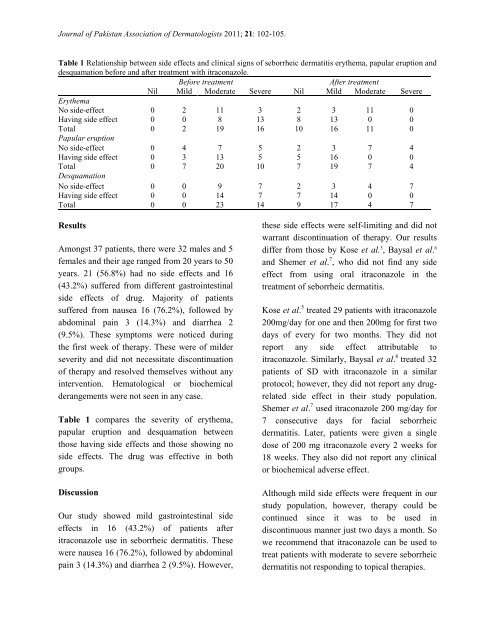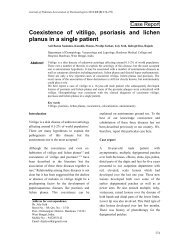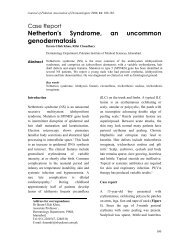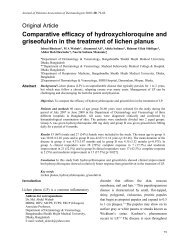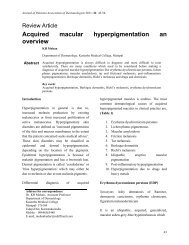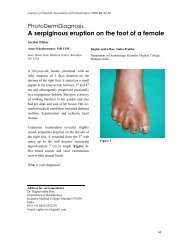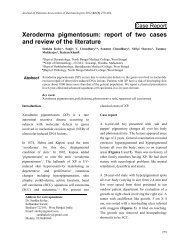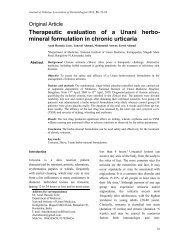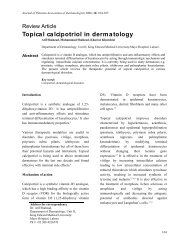Safety of oral itraconazole in the treatment of seborrheic dermatitis
Safety of oral itraconazole in the treatment of seborrheic dermatitis
Safety of oral itraconazole in the treatment of seborrheic dermatitis
Create successful ePaper yourself
Turn your PDF publications into a flip-book with our unique Google optimized e-Paper software.
Journal <strong>of</strong> Pakistan Association <strong>of</strong> Dermatologists 2011; 21: 102-105.<br />
Table 1 Relationship between side effects and cl<strong>in</strong>ical signs <strong>of</strong> <strong>seborrheic</strong> <strong>dermatitis</strong> ery<strong>the</strong>ma, papular eruption and<br />
desquamation before and after <strong>treatment</strong> with <strong>itraconazole</strong>.<br />
Before <strong>treatment</strong> After <strong>treatment</strong><br />
Nil Mild Moderate Severe Nil Mild Moderate Severe<br />
Ery<strong>the</strong>ma<br />
No side-effect 0 2 11 3 2 3 11 0<br />
Hav<strong>in</strong>g side effect 0 0 8 13 8 13 0 0<br />
Total 0 2 19 16 10 16 11 0<br />
Papular eruption<br />
No side-effect 0 4 7 5 2 3 7 4<br />
Hav<strong>in</strong>g side effect 0 3 13 5 5 16 0 0<br />
Total 0 7 20 10 7 19 7 4<br />
Desquamation<br />
No side-effect 0 0 9 7 2 3 4 7<br />
Hav<strong>in</strong>g side effect 0 0 14 7 7 14 0 0<br />
Total 0 0 23 14 9 17 4 7<br />
Results<br />
Amongst 37 patients, <strong>the</strong>re were 32 males and 5<br />
females and <strong>the</strong>ir age ranged from 20 years to 50<br />
years. 21 (56.8%) had no side effects and 16<br />
(43.2%) suffered from different gastro<strong>in</strong>test<strong>in</strong>al<br />
side effects <strong>of</strong> drug. Majority <strong>of</strong> patients<br />
suffered from nausea 16 (76.2%), followed by<br />
abdom<strong>in</strong>al pa<strong>in</strong> 3 (14.3%) and diarrhea 2<br />
(9.5%). These symptoms were noticed dur<strong>in</strong>g<br />
<strong>the</strong> first week <strong>of</strong> <strong>the</strong>rapy. These were <strong>of</strong> milder<br />
severity and did not necessitate discont<strong>in</strong>uation<br />
<strong>of</strong> <strong>the</strong>rapy and resolved <strong>the</strong>mselves without any<br />
<strong>in</strong>tervention. Hematological or biochemical<br />
derangements were not seen <strong>in</strong> any case.<br />
Table 1 compares <strong>the</strong> severity <strong>of</strong> ery<strong>the</strong>ma,<br />
papular eruption and desquamation between<br />
those hav<strong>in</strong>g side effects and those show<strong>in</strong>g no<br />
side effects. The drug was effective <strong>in</strong> both<br />
groups.<br />
Discussion<br />
Our study showed mild gastro<strong>in</strong>test<strong>in</strong>al side<br />
effects <strong>in</strong> 16 (43.2%) <strong>of</strong> patients after<br />
<strong>itraconazole</strong> use <strong>in</strong> <strong>seborrheic</strong> <strong>dermatitis</strong>. These<br />
were nausea 16 (76.2%), followed by abdom<strong>in</strong>al<br />
pa<strong>in</strong> 3 (14.3%) and diarrhea 2 (9.5%). However,<br />
<strong>the</strong>se side effects were self-limit<strong>in</strong>g and did not<br />
warrant discont<strong>in</strong>uation <strong>of</strong> <strong>the</strong>rapy. Our results<br />
differ from those by Kose et al. 5 , Baysal et al. 6<br />
and Shemer et al. 7 , who did not f<strong>in</strong>d any side<br />
effect from us<strong>in</strong>g <strong>oral</strong> <strong>itraconazole</strong> <strong>in</strong> <strong>the</strong><br />
<strong>treatment</strong> <strong>of</strong> <strong>seborrheic</strong> <strong>dermatitis</strong>.<br />
Kose et al. 5 treated 29 patients with <strong>itraconazole</strong><br />
200mg/day for one and <strong>the</strong>n 200mg for first two<br />
days <strong>of</strong> every for two months. They did not<br />
report any side effect attributable to<br />
<strong>itraconazole</strong>. Similarly, Baysal et al. 6 treated 32<br />
patients <strong>of</strong> SD with <strong>itraconazole</strong> <strong>in</strong> a similar<br />
protocol; however, <strong>the</strong>y did not report any drugrelated<br />
side effect <strong>in</strong> <strong>the</strong>ir study population.<br />
Shemer et al. 7 used <strong>itraconazole</strong> 200 mg/day for<br />
7 consecutive days for facial <strong>seborrheic</strong><br />
<strong>dermatitis</strong>. Later, patients were given a s<strong>in</strong>gle<br />
dose <strong>of</strong> 200 mg <strong>itraconazole</strong> every 2 weeks for<br />
18 weeks. They also did not report any cl<strong>in</strong>ical<br />
or biochemical adverse effect.<br />
Although mild side effects were frequent <strong>in</strong> our<br />
study population, however, <strong>the</strong>rapy could be<br />
cont<strong>in</strong>ued s<strong>in</strong>ce it was to be used <strong>in</strong><br />
discont<strong>in</strong>uous manner just two days a month. So<br />
we recommend that <strong>itraconazole</strong> can be used to<br />
treat patients with moderate to severe <strong>seborrheic</strong><br />
<strong>dermatitis</strong> not respond<strong>in</strong>g to topical <strong>the</strong>rapies.


